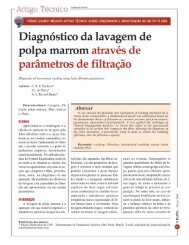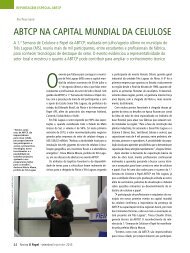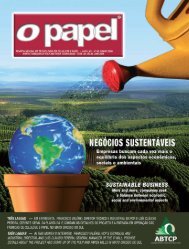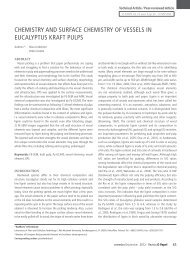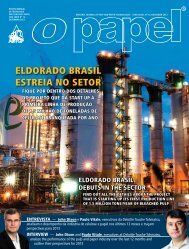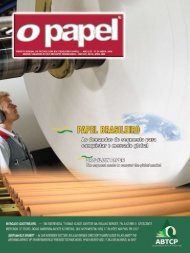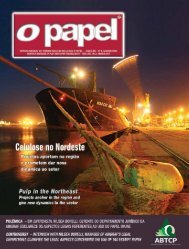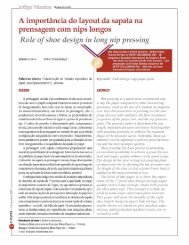international article - Revista O Papel
international article - Revista O Papel
international article - Revista O Papel
Create successful ePaper yourself
Turn your PDF publications into a flip-book with our unique Google optimized e-Paper software.
Índice de rasgo mNm 2 /g<br />
Tear index mNm 2 /g<br />
60<br />
55<br />
50<br />
45<br />
40<br />
35<br />
30<br />
25<br />
20<br />
15<br />
10<br />
10 12 14 16 18 20<br />
Grau de refinação, ºSR / Beating degree, ºSR<br />
Figura 5. Desenvolvimento do encurvamento das fibras celulósicas (pontos de dados cheios) e espessura média da parede celular Kajaani (pontos<br />
de dados vazios) durante os tratamentos sem carga / Figure 5. Development of the pulp fibre curl (filled data points) and average Kajaani cell<br />
wall thickness (hollow data points) during the no-load treatments<br />
2.55<br />
2.50<br />
2.45<br />
2.40<br />
2.35<br />
2.30<br />
2.25<br />
2.20<br />
Comprimento das fibras, mm<br />
Fibre length, mm<br />
2%<br />
4%<br />
6%<br />
O PAPEL vol. 70, num. 10, pp. 41 - 60 OCT 2009<br />
O PAPEL - Outubro 2009<br />
48<br />
rede do papel seco. Tal ativação das fibras ocorreria, portanto,<br />
através de tensões de endireitamento e secagem das fibras (em<br />
caso de papéis secados sob tensão), que melhoram a ativação<br />
dos segmentos de fibras e aumentam a rigidez axial das fibras.<br />
Uma consistência mais alta da polpa nos ensaios de refinação<br />
apresentados proporcionou um tratamento mais eficaz das<br />
fibras devido à maior quantidade de interação entre as fibras.<br />
O grau, ou intensidade, do tratamento mecânico das fibras fornecido<br />
refletiu-se no grau de aprimoramento das propriedades<br />
físicas das folhas feitas à mão.<br />
Geralmente as fibras ficavam mais longas (Figura 5) e perdiam<br />
o seu encurvamento original, exceto quando a 6% de consistência,<br />
caso em que se observou o aumento do encurvamento (Figura<br />
6). A máxima taxa de cisalhamento no afastamento de refinação<br />
estava na faixa de 7500 – 15000 s -1 , dependendo do raio do rotor<br />
e, assim sendo, as barras do rotor proporcionavam uma ação de<br />
aceleração e de dispersão das fibras. É óbvio que as fibras retidas<br />
pelas barras móveis eram submetidas principalmente a forças<br />
longitudinais, o que também é corroborado pelo aumento observado<br />
no comprimento das fibras. Assim sendo, a consistência da<br />
polpa afetou significativamente o modo do tratamento sem carga.<br />
Está bem fundamentado o fato de que uma consistência<br />
mais alta da polpa no processo de refinação proporciona um<br />
tratamento mais suave das fibras (Smith 1919, Casey 1960,<br />
Ebeling 1980, Hietanen 1991, Lundin 2008), que se deve ao<br />
maior número de fibras, ou massa, por volume submetido<br />
a tensão e subsequentemente menor, mas maior número de<br />
forças por fibra. As consistências de polpa usadas, de 2,4% e<br />
6% em peso, podem ser comparadas com o comportamento<br />
de deformação de 100 000, 200 000 ou 300 000 fibras num<br />
volume (3) de 1 mm 3 , o que ilustra que esse último caso, com<br />
force suppliers in the dry paper network. Such fibre<br />
activation would thus occur via fibre straightening<br />
and drying stresses (for restraint dried papers) that<br />
improve the fibre segments’ activation and increase<br />
the axial fibre stiffness. A higher pulp consistency in<br />
the presented refining trials provided a more effective<br />
fibre treatment due to greater amount of fibre-fibre<br />
interaction. The degree, or intensity, of the supplied<br />
mechanical fibre treatment was reflected in the rate<br />
of enhancement of the handsheet physical properties.<br />
Generally the fibres became longer (Figure 5) and<br />
lost their original curl, except at 6 weight-% where<br />
the curl was seen to increase (Figure 6). The maximum<br />
shear rate in the refining gap was in the range<br />
7500 – 15000 s -1 , depending on the rotor radius, and<br />
the rotor bars provided, thus, a fibre accelerating and<br />
dispersing action. It is apparent that the fibres trapped<br />
by the moving bars where subjected mainly to longitudinal<br />
forces, which also is supported by the observed<br />
increase in fibre length. The pulp consistency affected<br />
thus significantly the mode of the no-load treatment.<br />
It is well-established that a greater pulp consistency<br />
in refining delivers a milder fibre treatment<br />
(Smith 1919, Casey 1960, Ebeling 1980, Hietanen<br />
1991, Lundin 2008) that is due to higher number of<br />
fibres, or mass, per volume strained and subsequently<br />
smaller but greater number of forces per fibre. The<br />
used pulp consistencies, 2,4 and 6 weight-%, can be<br />
compared to the deformation behaviour of 100 000,<br />
200 000 or 300 000 fibres in a 1 mm 3 volume (3) , which<br />
illustrates that the latter case, with the greatest num-<br />
(3) O número de fibras SW por grama foi da ordem de 5 000 000. Portanto, em 1 mL de suspensão a 2% de consistência havia aproximadamente:<br />
2*5E6/100 = 100 000 fibras; 4*5E6/100 = 200 000 e 6*5E6/100 = 300 000 fibras por mL das suspensões a 4% e 6%, respectivamente<br />
The number of SW fibres per gram was of order 5 000 000. Thus, in 1 mL of a 2 weight-% suspension there were approximately:<br />
2*5E6/100 = 100 000 fibres; 4*5E6/100 = 200 000 and 6*5E6/100 = 300 000 fibres per mL of the 4 and 6 weight-% suspensions, respectively



